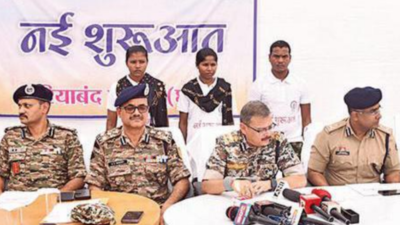- News
- City News
- raipur News
- Shaken by encounter that killed Chalapathy, 3 Maoists surrender in Chhattisgarh
Trending
Shaken by encounter that killed Chalapathy, 3 Maoists surrender in Chhattisgarh
Three hardcore Maoists, including two women, have surrendered in Gariaband, Chhattisgarh, following a significant encounter in Bhalludiggi hills that left 31 Maoists dead. The insurgents, carrying a combined bounty of Rs 18 lakh, expressed disillusionment with Maoist ideology and were swayed by the government's rehabilitation scheme.
RAIPUR: Three 'hardcore' Maoists, including two women, carrying a combined bounty of Rs 18 lakh, surrendered before police in Gariaband on Monday - the same district where 31 Maoists were gunned down in a single encounter in Bhalludiggi hills last month.
All three were involved in the 72-hour gunfight in Bhalludiggi on Jan 23 this year, in which 16 Maoists - including central committee member Jai Ram alias Chalpathy - were shot dead. Chalpathy is the most senior Maoist commander to be killed in Chhattisgarh.
The surrendered Maoists have told police how badly shaken the insurgents are following the hilltop encounter.
Raipur range IG Amresh Mishra identified the surrendered cadres as SDK area committee deputy commander Dilip alias Santu, who carried a bounty of Rs 8 lakh, Manjula alias Lakhmi, a member of the same unit as Santu, and Sunita alias Junki of Bargarh Area Committee. The two women carried bounties of Rs 5 lakh each. Dilip handed in an Insas rifle - a rarity.
Manjula is from Gondigudem village in Sukma district, and joined the Maoist ranks in 2016. He began with Kistaram Area Committee and was then moved to SDK area committee and participated in numerous operations, including the ones in Sikaser and Bhalludiggi. So was Sunita, who is from Poten village in Bijapur district and was in the insurgent ranks for 15 years.
Dilip, who was deputy commander of Nuapada Division Committee, has said that Maoists are terrified after the Bhalludigi encounter, especially small-time cadres. Relentless pressure from police is forcing insurgents to constantly change hideouts, sometimes multiple times every night, and they are also struggling for food and basic supplies, he has revealed.
Dilip also said that he was injured in an encounter and has now received treatment with the help of police. According to him, there are around 64 active Naxals in Gariaband district. Police used this opportunity to launch the ‘Poona Moddol’ (New Beginning) campaign.
According to police, the trio felt disillusioned with the Maoist ideology and grew increasingly frustrated due to the atrocities committed by their fellow comrades. They were swayed by govt’s rehabilitation scheme, which helps surrendered cadres start a better life and decided to turn themselves in, said police.
“The three Maoists chose to give up arms and return to mainstream society, reflecting the success of govt’s continuous efforts in spreading awareness about its rehabilitation and surrender policy. These efforts, especially in Maoist-affected interior regions, have led to increasing numbers of surrenders,” Raipur range IG Amresh Mishra told TOI.
The surrendered cadres have told police about forceful recruitment and exploitation of local youth, harassment of innocent villagers, extortion, and destruction of developmental works.
They said they were particularly moved by the contrast between the hardships of life in the forests as a fugitive and the peaceful, prosperous lives led by those who had surrendered under the scheme, say police.
Maoists in Panic After Bhalludigi Encounter
Surrendered Maoist Dilip, the deputy commander of Nuapada Division Committee, has revealed that insurgents are terrified after the Bhalludigi encounter, especially small-time cadres.
Thirty-one Maoists were killed in the 72-hour gunfight (Jan 20-23), including central committee member Chalapati and division commander Satyam Gavde. The slain Naxals carried a total bounty of over Rs 3 crore. The battle was a massive operation aimed at eliminating Naxal presence in the region.
The Naxals had come to Bhalludigi Tola in Kulhadi ghat panchayat area of Gariaband on Jan 20 in search of food and found themselves surrounded by security forces. The Kulhadi Ghat area, located in the hills, was known as one of the safest zones for Maoists. They used this corridor to travel between three states. The operation was conducted jointly by Chhattisgarh and Odisha forces, with 10 teams, including three from Odisha, two from Chhattisgarh police, and five from CRPF.
The successful operation was lauded by Union home minister Amit Shah, who remarked that Naxalism was nearing its end

About the Author
Rashmi DroliaEnd of Article
FOLLOW US ON SOCIAL MEDIA









